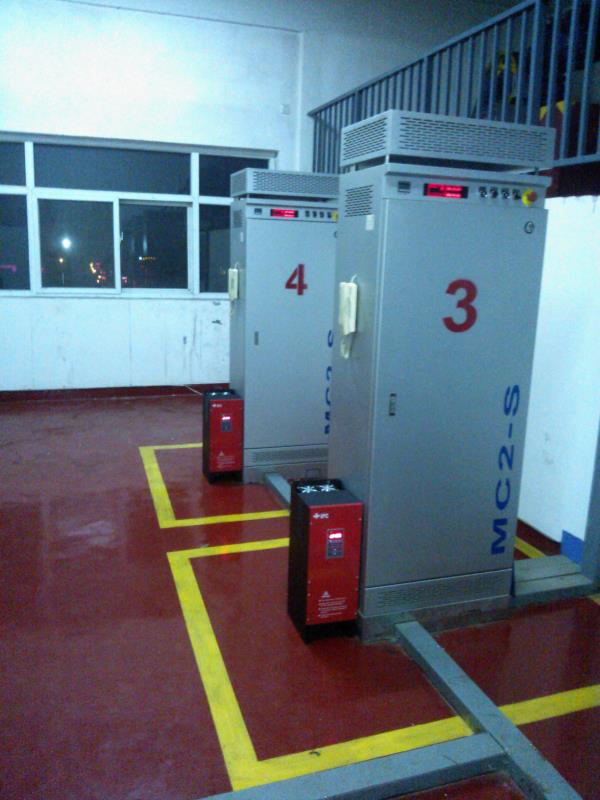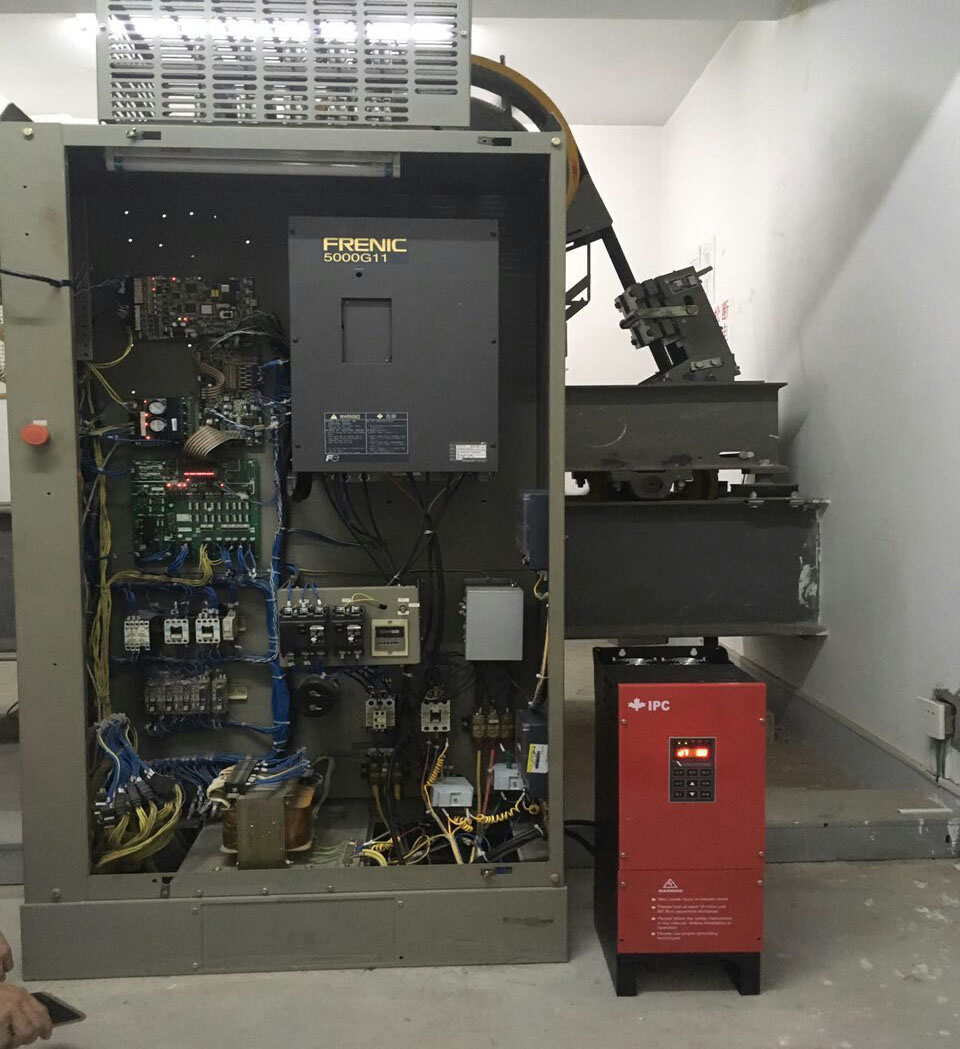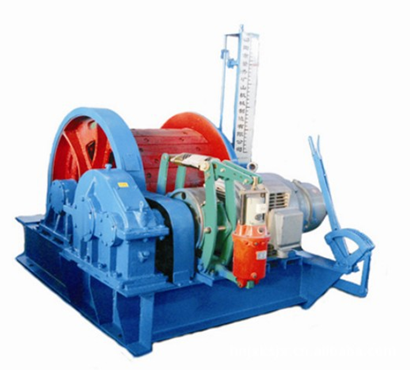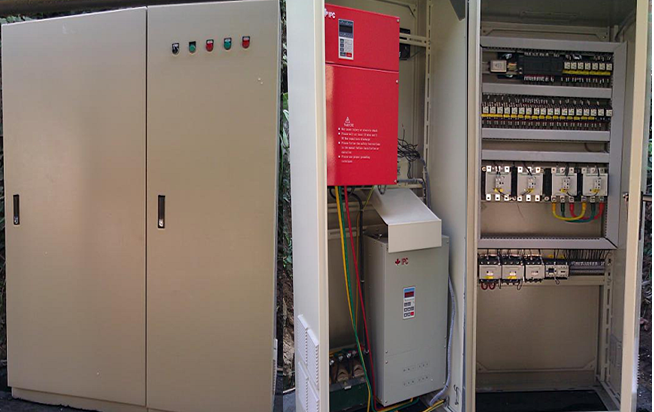3. Energy saving transformation system for frequency conversion feedback of mine winch
After the transformation of the mine winch system, the motor of the mine winch lifting mechanism was infinitely variable speed, greatly improving the control performance of the lifting mechanism and reducing the huge impact on the motor and mechanical parts. At the same time, energy feedback will enhance the regenerative energy of the motor to be fed back to the grid, greatly saving electricity, reducing the ambient temperature of on-site equipment operation, and extending the service life of electrical equipment. The energy-saving renovation system has two control cabinets, consisting of a frequency converter and an energy feedback device PLC、 The specific functions of the contactor and other components are summarized as follows:
1. After the system transformation, the variable frequency feedback control mode of the motor can be freely switched with the original rotor series resistance power frequency control mode, and the two control modes are electrically interlocked to ensure the safety of the system operation.
2. After the system transformation, the original operation mode and habits of the mine winch will be retained, that is, the gear control and operation mode of the original cam controller will be retained. In this way, it will not affect the normal operation of the mine winch operator and ensure that the special equipment inspection of the mine winch is qualified.
3. The variable frequency feedback electrical control system of the lifting mechanism has multiple protection functions such as short circuit, overvoltage, overcurrent, phase loss, overload, and over temperature, to maximize the protection of the lifting mechanism of the mine winch.
4. The system adopts a frequency converter to drive the lifting mechanism motor. When the motor drives the potential load to be lowered, the motor will be in a regenerative power generation state. The energy feedback device will feed back the regenerated energy of the motor in the generating state to the power grid, ensuring the normal operation of the variable frequency system and greatly saving electricity.
4. System debugging
① Debugging of PLC programs and control circuits. After the equipment installation is completed, the control circuit is powered on and the main circuit is not powered on. Perform control circuit and PLC program debugging to ensure correct logic control of the control circuit and PLC, and normal operation of all components.
② Debugging of frequency converter.
Disconnect the mine winch motor from the reducer, and use V/F control mode for no-load operation of the frequency converter. Drag the motor to ensure stable and normal operation of the motor, and the output voltage and current of the frequency converter are normal.
Disconnect the mine winch motor from the reducer, and use a PG free vector control method for the frequency converter to perform rotational self-learning and obtain motor parameters. Then, the PG free vector control method is used for no-load operation, dragging the motor and adjusting the corresponding parameters to ensure stable operation of the motor. The output voltage and current of the frequency converter are normal.
Connect the winch motor to the reducer, and use PG free vector control for the frequency converter. Run the frequency converter with load to ensure stable motor operation.
③ Debugging of energy feedback device.
Conduct no-load and heavy load lowering tests on the mine winch, correctly set the feedback action voltage value of the energy feedback device, and ensure the normal operation of the frequency converter and energy feedback system.
④ The overall debugging and operation of the system.
The entire system undergoes overall testing to ensure that the mine winch is lifted and lowered without load, lifted and lowered under heavy load, the speed of each gear meets the requirements, the gear shifts are normal, and the frequency converter and energy feedback device operate normally. And conduct work and frequency conversion switching tests to ensure normal switching and normal power frequency operation.
4、 The Application Effect and Customer Evaluation of IPC Frequency Conversion Feedback Electric Control System in Energy saving Renovation of Mine Winches
El funcionamiento real del sistema ha demostrado que la aplicación del sistema de control eléctrico de realimentación de frecuencia variable IPC en la modernización para el ahorro energético de los cabrestantes mineros no altera su modo de operación original, y el freno de mano original prácticamente ya no se utiliza, simplificando así la operación. El sistema funciona de forma estable y fiable, con un excelente rendimiento de regulación de velocidad y un elevado par de arranque y par de salida a baja frecuencia. Al descender el mecanismo, el excedente de electricidad generado por la regeneración del motor se inyecta a la red, lo que supone un importante ahorro energético. El cliente está muy satisfecho con la eficacia del sistema de control electrónico de realimentación de frecuencia variable IPC en la modernización para el ahorro energético de los cabrestantes mineros. Tras las mediciones, el sistema de control electrónico de realimentación de frecuencia variable IPC permite ahorrar más del 28 % de energía eléctrica en comparación con el método original de regulación de velocidad por resistencia en serie del rotor del motor del devanado del cabrestante minero.
5. Conclusión
La aplicación del sistema de control electrónico de retroalimentación por conversión de frecuencia IPC en la transformación para el ahorro de energía de los cabrestantes mineros ha mejorado el nivel de automatización de estos equipos en la industria minera y ha acelerado la modernización de los equipos industriales. Ha desempeñado un papel muy positivo en el aumento de la capacidad productiva de la industria minera y en la garantía de su seguridad.
Más importante aún, el equipo de elevación minera pertenece a la maquinaria minera de gran escala, y su consumo energético representa una proporción significativa del consumo total de energía de toda la producción minera. En comparación con el sistema de control de velocidad por resistencia en serie del rotor del motor bobinado, el sistema de control eléctrico de realimentación de frecuencia variable permite un ahorro considerable de electricidad, reduciendo así los costos de producción y generando beneficios económicos para la industria minera.













































